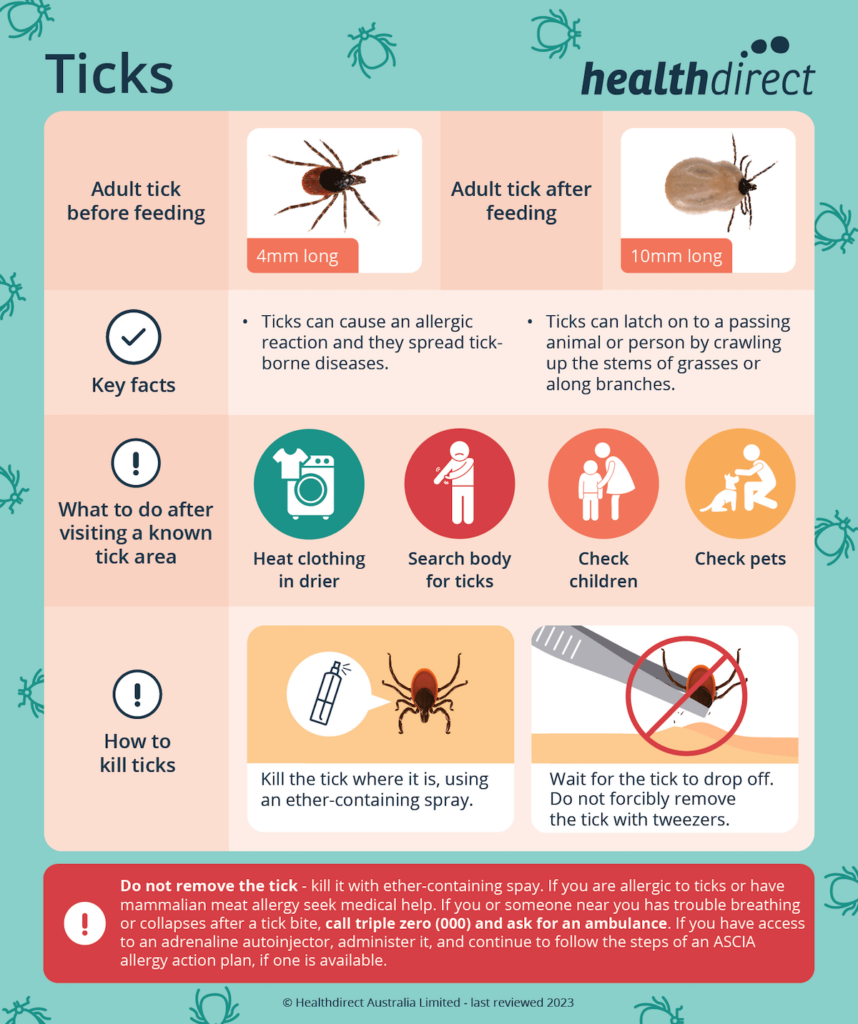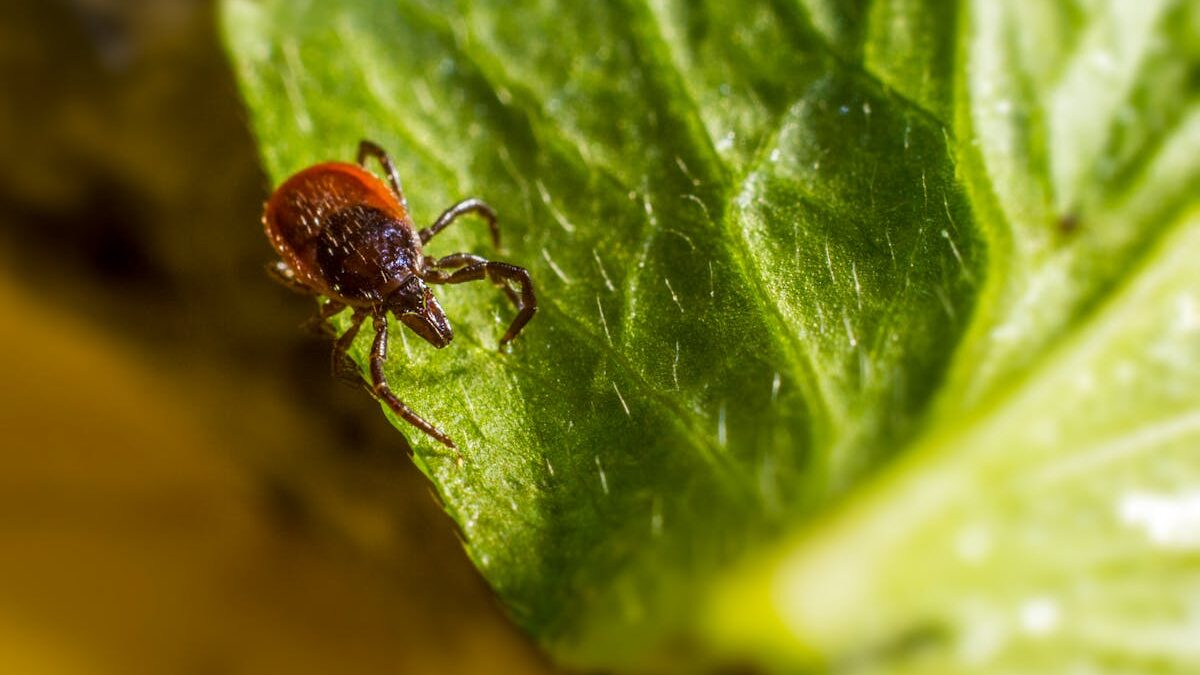Tick bites can pose risks to children and pets and cause diseases. Learn how to prevent and manage bites effectively.
Ticks are tiny, blood-sucking arachnids that can significantly impact human and animal health. These small, seemingly innocuous creatures can transmit serious diseases through their bites, making them a critical health risk.
Their small size make them challenging to notice, as they are usually the same size as the full stop at the end of this sentence. Once a tick has joined itself to a warm-blooded creature, it will expand greatly in size. However, this is usually several days after the initial bite.
While they are found worldwide, ticks prefer to set up their nests in scrubby bushland, rainforests and wooded areas. The abundance of leaf litter in these places provides ideal hiding places for ticks.
Understanding when ticks are most active, how they transport themselves and what risks tick bites pose to humans is essential for staying safe, especially during peak tick season.
Peak tick season
Ticks are most active during the warmer months, typically from spring to early autumn. However, they can be found year-round in the northern regions of Australia, where the climate is warmer. The highest risk of exposure is over summer, as the humid conditions are ideal for ticks to thrive.
Ticks do not jump or fly. Instead, they rely on “questing” to find a host. This is when the tick climbs to the top of a blade of tall grass, leaf or other vegetation, and extends its legs to grab onto a passing host. Once a host, such as a person, dog or other animal, brushes past, the tick latches onto the skin and begins feeding, often for several days, if uninterrupted.
If possible, avoid areas with high tick populations, bush and long grass. Wear protective clothing (long pants tucked into socks and long sleeves). Use insect repellents that contain DEET or picaridin to further protect yourself and your children. Always check for ticks when you are back home.
Different types of ticks
There are two main categories of ticks: Ixodidae (hard ticks) and Argasidae (soft ticks). Within these two groups, there are hundreds of varieties, of which around 70 are found in Australia, particularly on the east coast.
Some of the more well-known ticks include:
- paralysis tick: usually a white-grey colour, similar to a pencil eraser
- cattle tick: brown with yellow-lined markings on the back
- bush tick: similar looking to the cattle tick
- brown dog tick: dark brown
- kangaroo tick: dark red, with silver patches
- southern reptile tick: dark brown
The type of tick will vary depending on where you live and it is best to seek health information from a trained specialist in your area.
The risks and side effects of tick bites
Ticks pose several health risks to humans, ranging from mild allergic reactions to more severe conditions such as tick paralysis, anaphylaxis and the transmission of tick-borne diseases. Understanding these risks is critical for early recognition and treatment.
Symptoms of tick paralysis include:
- weakness or lethargy
- unsteady walking or poor balance
- loss of appetite
- blurry vision
- slurred speech
Ticks can sometimes cause illnesses such as:
- rickettsial diseases including Flinders Island spotted fever and Queensland tick typhus
- Lyme disease-like conditions, known as Debilitating Symptom Complexes Attributed to Ticks (DSCATT)
Some people who have had tick bites may experience swollen lymph nodes (glands), muscle or joint aches, stiff neck, flu-like symptoms or sudden facial paralysis (Bell’s palsy). Chronic co-infections can also occur for tick bites that are not treated. These can mimic almost any disease, including autoimmune conditions, severe neurological disorders, mental health conditions and even some types of cancer.
The main diseases of concern in some other countries are not currently present in New Zealand.
What about Lyme disease?
Tick bites can cause various illnesses, but Lyme disease does not occur in Australia. Australian ticks are not known to carry borrelia burgdorferi, the bacteria that causes Lyme disease in other parts of the world.
Some Australians who have never left Australia have claimed to have tested positive for Lyme disease or experience the symptoms for Lyme disease. As testing in Australia is limited and may return false negatives, those who suspect they have Lyme or other tick-borne disease may have to seek specialised laboratories internationally.
While not everybody will get it, the first symptom of Lyme disease is usually a pink or red rash. It starts as a small red spot that gradually spreads into a much larger circle. It will gain a bulls-eye appearance and is called erythema migrans.
Tick removal: What to do if you find a tick on your body

If you find a tick attached to your skin or your child’s, the key is to remove it as safely and quickly as possible (if you’re not allergic to ticks). Here’s how:
- Do not disturb the tick: In Australia, it’s recommended to kill the tick before attempting removal. You can use an ether-containing spray (available from pharmacies) to freeze the tick in place and kill it. This minimises the risk of the tick injecting more toxins.
- Remove the tick: Once the tick is dead, it should fall off. You can also try to brush it away. Avoid forcibly removing the tick using tools such as tweezers. (Freeze don’t squeeze.)
- Clean the area: After removing the tick, clean the bite site with antiseptic and wash your hands thoroughly.
If you are allergic to ticks or are unsure, seek medical help.
For more information on tick bites, check out the Health Direct page.
Prevention is the best cure
Knowing the risk factors relevant to your location and the types of ticks you may be exposed to is essential. Always check yourself and your children after visiting a known tick area or returning from a bush walk.
Ticks are drawn to warm-blooded mammals. This means your dogs or any other pets. So check them regularly for ticks too and speak to your vet about preventive medication.
If you suspect you have a tick-borne illness or are experiencing complex health issues that are not responding to treatment, you may want to try the Multiple Systemic Infectious Diseases Syndrome questionnaire.
How helpful was this article?
Click on a star to rate it!
0 / 5. 0
Be the first to rate this post!
Adriana Wales
Related posts
Subscribe
Receive personalised articles from experts and wellness inspiration weekly!

